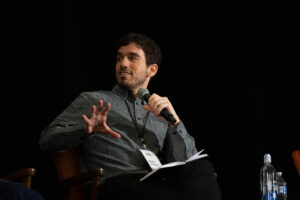“The human component is always in the middle,” said Sebastián Auyanet Torres, Audience Strategist at NowThis, when referring to artificial intelligence (AI) initiatives during the final panel at the 25th International Symposium on Online Journalism (ISOJ) on April 13.

A panel discussion on artificial intelligence closed the second and final day of the 25th ISOJ. (Patricia Lim/Knight Center)
The panel featured several technology specialists including Andrea L. Guzman, associate professor, Northern Illinois University; Nicolás Grossman, deputy project director, Global Index on Responsible AI & Global Data Barometer, Argentina; and Sil Hamilton, researcher in residence, Hacks/Hackers, Canada.
The conversation, led by assistant professor at the University of Texas’ School of Journalism and Media Josephine Lukito, discussed each panelist's personal definition of AI and perspectives on how AI has played a role in their career recently.
Grossman started the discussion by defining AI as a “key tool to organize research,” and proposed that the audience think about AI as a “set of technologies” that performs tasks in an autonomous way that was previously thought to only be achievable by humans.
“[AI] are seen as a solution for many of the problems that I face now,” Grossman said. “And also are posing new threats to society or strengthening old problems.”
While Guzman defines AI as a sort of communicative other, many consumers think of the “Hollywood Effect” as she described hearing from over 100 people that they believe AI is anything from the Terminator and aliens to Siri and Alexa.
Hamilton’s definition went back to the roots of the term, coined in 1958 at Dartmouth University with the idea that the brain computes through logical operations, computer science researchers wanted to mimic that brain function with a computer.
Torres, coming from a practice point of view, describes AI as a “compound of technology” that has allowed him to save time and focus on human capabilities as an audience strategist. He offers journalists a new perspective calling AI “AE”, meaning actual experience treating AI as a means to an end not just an end in content production.
Beyond the general concern about the ethics of using AI in the newsroom, the panelists brought up compelling points about the efficiency and safety of bringing AI into journalism.
Hamilton expressed gratitude for AI use in lower-level work like transcribing, summarizing interviews, generating titles and writing captions due to its efficiency. However, he expressed concern stating that the real danger is the belief that AI is advanced enough to complete the higher-level tasks that humans currently run.
“We’ve seen newsrooms be whittled down, more is expected of us,” said Northern Illinois University associate professor Guzman. “Part of this fear about artificial intelligence has nothing to do with AI itself.”
Guzman continued that highlighting questions about AI can’t be disentangled from the economic question. Rather than a fear of the technology, journalists fear AI undermining their agency. She suggests that journalists think of AI in relation to the funding models.

Nicolás Grossman, deputy project director, Global Index on Responsible AI & Global Data Barometer in Argentina, helped lead a vibrant discussion of AI at the 25th ISOJ. (Patricia Lim/Knight Center)
“It’s not AI that’s going to save or ruin journalism,” said Guzman. “It’s people making decisions about what is journalism and what do people value in journalism and what value are we going to put in journalism.”
So, what should journalists do when faced with the increasing abilities of AI?
The consensus from Torres and Hamilton is that AI is still not fool-proof, citing that we still lack the tools and training needed to proficiently detect the use or misuse of AI. “Chat GPT was given one goal and one goal only, that was to mimic human text,” said Hamilton in response to why we need humans to detect false content rather than computers who are blind to tell-tale inconsistencies.
Guzman says that the firehose of misinformation and disinformation is not used as a tactic to change minds, but to further informational bias and confuse the public. She explained that she is teaching her students to work, experiment, and “play” with AI to demystify some of the fears her students may have about its capabilities and limitations.
Torres, perhaps offered the most optimistic approach suggesting that students should empower themselves to do whatever it is they want to do and see how AI can help their career. Journalism students should have dynamic conversations about what AI can do for us rather than to us as journalists.
ISOJ is a global online journalism conference organized by the Knight Center for Journalism in the Americas at the University of Texas at Austin. In 2024, it is celebrating 25 years of bringing together journalists, media executives and scholars to discuss the impact of the digital revolution on journalism.
*Paisley Porter is a second-year Communication and Leadership & Journalism student at UT Austin. She is currently an anchor and a senior Life & Entertainment correspondent for the Texas Student Television News Department.